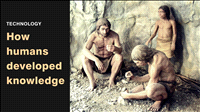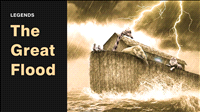The Great Flood | Flood myth | Legends
By Kiron Kasbekar | 20 Nov 2022
I am going to talk about the legends that surround the Great Flood – the flood that covered the whole Earth, and from which a handful of people were saved, reportedly by God’s grace, to return and re-start the human race.
A rebooting of humanity, in a way, after being practically booted out of existence.
A legend is a folk tale that narrates some dramatic human actions that happened long, long ago. Legends may include miracles, and may get transformed over time to keep them interesting. In a few cases, legends have traveled across different cultures and got transformed to replace the original names of people and places with local names.
This is what seems to have happened in the case of the legend of the great floods that covered the earth some thousands of years ago after the last Ice Age ended and the melting ice caused waters to flood the earth.
All major religions have this legend of how, a long, long time ago, sea levels rose and flooded the entire earth. Stories were spun around this theme all over the world.
The first of these stories was about Gilgamesh in Mesopotamia, the area we know today as Iraq.
Then came the story of Noah, as the Jews and Christians know him, or Nuh as he is called by Muslims.
Similar stories abound in areas as far from the Middle East as China and the Americas.
But let’s look at them one by one.
Gilgamesh lived in ancient Mesopotamia and was the hero of the Epic of Gilgamesh, a poem written in the Akkadian language during the late 2nd millennium BC. The poem chronicles the tale of Utnapishtim, who is said to have saved the earth from a flood that covered the entire globe.
Utnapishtim is commanded by the god Enki, also known as Ea, to create a giant ship to be called Preserver of Life in preparation of a giant flood that was going wipe out all life on earth. As a reward for his service, Utnapishtim is rewarded with eternal life. Centuries later, Gilgamesh, a historical king of the Sumerian city-state of Uruk sometime between 2900 and 2350 BC – i.e., between four thousand and five thousand years ago, meets Utnapishtim. And Utnapishtim narrates the story of the Great Flood to him.
And the epic goes something like this:
There was a time when there were Anunna, the superior gods, and there were Igigi, the inferior gods who had to do forced labor. The Igigi had to do heavy labor, their drudgery was great, and their misery became unbearable.
The Igigi gods dug canals that became the life of the land. They dug the Tigris river, and then they dug the Euphrates river. They opened springs from the depths, and dug wells. They heaped up all the mountains.
They spent an agonizing number of years suffering this drudgery day and night. They muttered, they complained, they denounced the superior gods, but the higher gods were unmoved.
Eventually the Igigi could not bear the suffering any longer. They were furious with Enlil, warrior counsellor of the gods. They decided to storm Enlil’s palace, drag him out, beat him up, and then start a war against all the upper gods.
They set fire to their tools, to their baskets and to their workspaces, and marched, one and all, to the gated of Enlil's abode.
The Great Gods sent a messenger to ask, ‘Who is the instigator of these hostilities? Who has declared war on us? Who had brought battle to Enlil’s gates?
And the lower gods declared, ‘Every one of us gods has declared war; we have been forced to excavate the earth, and that has become unbearable; it is killing us.’
So the greater gods decided to create man, to relieve the lower gods from their misery. They slaughtered the leader of the rebellious lower gods as punishment for his revolt, and from his blood they created mankind to do the labor which the lower gods did earlier.
All is well for some time. Then the human population increases, and their noise disturbs the gods. So the gods decide to wipe out mankind.
But the god Enki has some reservations about this, so he sends a dream to a wise man named Atra-hasis. Enki advises Atra-hasis to flee from his house, build a boat, and save the lives of some humans.
Atra-ḥasis then meets the elders in his village, and tells them, ‘My god does not agree with your god, and Enki and Enlil are forever angry with each other. Now Enki has told me this – that I cannot set my feet on the earth of Enlil.
I will dwell with my god in the depths.
Immediately thereafter, Atra-ḥasis begins building the Ark, the great boat, with the help of some local artisans. Then, just before the Great Flood hit the earth, they ushered a large number of animals onboard, and then sealed the boat with tar so it would keep the water out.
When the Great Flood came, the great boat floated on the water – and Atra-ḥasis and all the humans and animals he had brought on board the Ark were saved. When the flood receded, they returned to land to recreate the populations of humans and animals.
Now let’s look at another legend. That is Noah, the hero of the Genesis flood story, the Hebrew and Christian version, or Nuh, the Islamic version of the same hero, of the universal flood myth. This myth talked of God's decision to return the world to its pre-creation state of watery chaos and then reshape it through what was left on Noah's ark.
Noah built a huge wooden ship, called the Ark, on which he invited one male and one female of every species in the world. When the flood came, Noah’s Ark floated in the waters and was guided to Mount Ararat, which is in present-day Turkey close to the Iranian and Armenian borders.
The Noah story is also thought to have originated in ancient Mesopotamia. The Book of Genesis in which Noah figures is thought to have been composed around the 5th century BCE, i.e., about 2,500 years ago.
In Hindu mythology, Manu, the first human in this cosmic age, was forewarned about the flood by the Matsya Avatara (or incarnation as a fish) of Vishnu, one of the three gods in the divine trinity in Hinduism.
Manu saved mankind by building a boat that carried his family and seven sages to safety, guided by a huge horned whale-like fish – Vishnu’s avatar called the matsyavatar. Manu tied the boat to the horn of the fish, as the fish advised, and was steered to safety to the top of a mountain.
Flood myths abound elsewhere in the world too, from China and Greece to Peru. Which is expected, for when the water levels rose, they would have risen all over the world connected by its many oceans and seas. Type what I said here.
In Chinese mythology, a black turtle and a yellow dragon saved the people from a devastating flood sometime in 2300-2200 BCE, during the reign of Emperor Yao. The flood is said to have lasted for two generations.
Greek mythology talked of the problematic Pandora's Box – when that box was opened, it let loose all kinds of terrible things in the world. There were murders, riots and wars. So, Zeus, the king of gods, decided that creating man was a mistake, and ordered the sea waters to rise and flood the earth.
Only two people survived that flood – King Deucalion, the most honest man on earth, and his wife, Pyrrha. This was because Prometheus, the god who had given mankind the gift of fire, had warned King Deucalion, his son, that a flood was coming.
He told his son to build a strong boat and stock it with all necessities. King Deucalion followed his father’s instructions, and when the floods came, their boat rode the waves for 9 days and 9 nights. And then the boat settled down on top of the tallest peak in Greece, Mount Parnassus.
Why am I talking about flood myths? Let me explain.
First, ignore the imagery involved, of gods, animals, and extraordinary humans who could build super-massive boats that could carry pairs of every animal that inhabited the earth over a rising sea.
How big would that boat have to be? And how many cans of food and adequate refrigeration for the food would have been needed to last all the animals for the entire duration of the flood, which was a hundred and fifty days in some cases and two whole generations in others?
And there are other fanciful thoughts in these fables, such as that Noah lived to the age of 950 years (which by itself indicates how it was a tale spun from imagination).
From Lake Huron and British Columbia in North America through Mexico and Central America to Lake Titicaca between Peru and Chile, and to Patagonia, which covers parts of Chile and Argentina, American Indians remembered and saved their own versions of the ancient deluge.
Naturally, the Andean Indians had their own names for the deluge, In the Quechuan languages in Peru they called it ‘Llocllay Pachacuti’, meaning ‘universal flood’. That flood, they said came towards the end of Purunpacha, the time of which there is no memory. But they say God drowned the world in water because of the sins of mankind.
Note that the animal actors in the play were also different here. The Indians in the Cuzco region of Peru believe that when the flood was about to come, for a whole month, the llamas which are bred sheep in this region, were so filled with sorrow that they didn’t eat, and gazed anxiously at the stars at night, until one day a shepherd asked the animals why they were so sad.
They said they were looking at some stars which were conspiring to destroy the world through a flood. When he heard this, the shepherd told his six sons and daughters, and to gather food and cattle, and climb the high hill called Ancasmarca. When the waters rose and flooded the earth, the hill rose, and floated, and when the water subsided, the hill lowered itself and returned to its old place. And from the children of the shepherd who survived the flood, the province was repopulated.
In another story, when one Indian tied up his llama in a good pasture the llama said, ‘Loco, I am worried, and you know why? It’s because in less than five days the sea will rise until it covers the whole earth. You must take refuge on the summit of the mountain.’
So the man packed his belongings on his back, took the llama on a leash, and arrived at the summit of the mountain where he found many diverse animals and birds huddled together.
When the waters rose, the summit of the mountain remained safe. Thus the entire earth was cleansed of all evil people and the good Indian was saved to rebuild the human race.
Curiously, one country that you’d expect to have an abundance of flood myths doesn’t have any – and that is Japan.
Some 19th century Japanese scholars used the fact that Japan lacks a major flood myth to argue for the supremacy of the Shinto religion and to promote Japanese nationalism.
But I am guessing that the lack of a flood myth in Japan possibly indicates that maybe the people who form the main population of Japan today migrated there well after the Great Flood.
Anyway, interesting stories. But they are more than just stories spun out of thin air. There must be a grain of truth behind the stories.
For it seems clear that at some point in the very distant past there was a great flood that covered the earth. And that could only have happened because of the polar icecaps melting and bringing many gigatons of water to the seas, raising their levels to such heights that human and animal habitations were destroyed and only that life survived which was already on higher ground, or was able to migrate to higher ground.
On the face of it these tales may seem different because they have people with different names, there are variations in the other people or animals they save, and they differ in the animals that helped them through the floods.
But some things are common:
- One, mankind became wicked and offended the gods;
- Two, God or the gods brought a worldwide flood that destroyed the sinners and purified the earth; and
- But, three, God or the gods did spare one family of humans or a small group, who sought refuge on mountain tops,
- And, four, then they rebuilt a new, improved human race.
While the Biblical story is the most recognized worldwide, there are equally interesting stories that American Indians believe which are so similar.
Isn’t it surprising that they are so similar despite the fact that there are big oceans separating them from one another? Well, maybe it’s not so surprising if you consider how humans originated in Africa, and spent many centuries in and around the region we know as the Middle East before they moved out northwards and eastwards right until their eastern journey took them via Siberia and Alaska to the southernmost tip of South America.
And if the great flood happened once, it can happen again. And not only can it happen again, it is happening again. Sea levels are rising, and coastal cities and villages are going to be water-logged in another three decades.
Watch full video: https://youtu.be/QuMjmTzvXqk




























